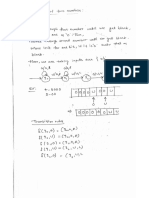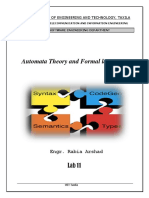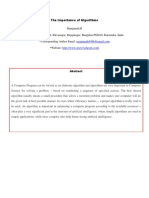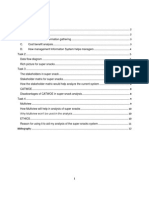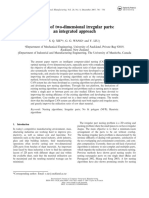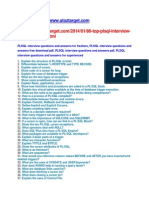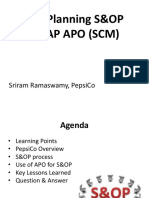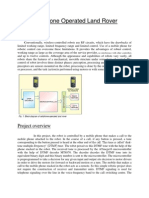Principal Programming Language (RGPV)
Uploaded by
mickey singhPrincipal Programming Language (RGPV)
Uploaded by
mickey singhSubject Name: Principles of Programming Languages
Subject Code: CS-6002
Semester: 6th
Downloaded from be.rgpvnotes.in
Subject Notes
Department of Computer Science and Engineering
Subject Name: PPL Subject Code:CS6002
Unit-1
Language Evaluation Criteria
The following factors influences Language evaluation criteria
1) Readability 2) Simplicity 3) Orthogonality 4) Writability 5) Reliability 6) Cost
1. Readability
• One of the most important criteria for judging a programming language is the ease with which programs
can be read and understood.
• Language constructs were designed more from the point of view of the computer than of computer users
2. Overall simplicity
• Language with too many features is more difficult to learn
• Feature multiplicity is bad. For example: In Java, increment can be performed if four ways as:
Count= count+1
Count+=1
Count++
++count
• Next problem is operator overloading, in which single operator symbol has more than one meaning.
3. Orthogonality
• A relatively small set of primitive constructs that can be combined in a relatively small number of ways
• Consistent set of rules for combining constructs (simplicity)
• Every possible combination is legal
• For example, pointers should be able to point to any type of variable or data structure
• Makes the language easy to learn and read
• Meaning is context independent
• Lack of orthogonality leads to exceptions to rules
• C is littered with special cases
Orthogonality is closely related to simplicity. The more orthogonal the design of a language, the fewer
exceptions the language rules require. Fewer exceptions mean a higher degree of regularity in the design,
which makes the language easier to learn, read, and understand.
– Useful control statements
– Ability to define data types and structures
– Syntax considerations
4. Writability - Writability is a measure of how easily a language can be used to create programs for a chosen
problem domain and can be directly related to:
– Most readability factors also apply to writability
– Simplicity and orthogonality
– Control statements, data types and structures
– Support for abstraction
5. Reliability-
A program is said to be reliable if performs to its specifications under all conditions.
Type checking
• Type checking is simply testing for type errors in a given program, either by the compiler or during the
program execution
Page no: 1 Follow us on facebook to get real-time updates from RGPV
Downloaded from be.rgpvnotes.in
• Because run time type checking is expensive, compile time type checking is more desirable
• Famous failure of space shuttle experiment due to int / float mix-up in parameter passing.
Exception handling
• A ility to intercept run-time errors
• A ility to use different names to reference the same memory
• A dangerous feature
6. Cost-
The cost is also an important language evaluation criteria. The total cost of a programming is a function of cost
of training to programmers, cost of writing programs, cost of compiling programs, cost of executing programs,
cost of maintaining programs.
Influence on Language design
1. Computer Architecture
2. Programming Methodologies
Computer Architecture Influence
– Data and programs stored in memory
– Memory is separate from CPU
– Instructions and data are piped from memory to CPU
– Basis for imperative languages
• Variables model memory cells
• Assignment statements model piping
• Iteration is efficient
structured programming
Programming Methodologies Influences
– top-down design and step-wise refinement
Process-oriented to data-oriented
– Data abstraction
Object-oriented programming
– Data abstraction + inheritance + polymorphism
Scientific applications-– Large number of floating point computations. The most common data structures
Programming Domain
are arrays and matrices; the most common control structures are counting loops and selections. The first
language for scientific applications was FORTRAN, ALGOL 60 and most of its descendants. Examples of
languages best suited: Mathematica and Maple.
• Business applications- Business languages are characterized by facilities for producing reports, precise
ways of describing and storing decimal numbers and character data, and ability to specify decimal arithmetic
operations. Its uses for decimal numbers and characters. COBOL is the first successful high-level language for
those applications.
• Artificial intelligence- In AI Symbols rather than numbers are typically manipulated. Symbolic computation is
more conveniently done with linked lists of data rather than arrays. This kind of programming sometimes
requires more flexibility than other programming domains. The first AI language was LISP and is still most
widely used
• Systems programming- The operating system and all of the programming support tools of a computer
system are collectively known as systems software. It needs for efficiency because of continuous use and low-
level features for interfaces to external devices
Page no: 2 Follow us on facebook to get real-time updates from RGPV
Downloaded from be.rgpvnotes.in
• Special-purpose languages
– RPG (Report Program Generator) : business reports
– APT (Automatically Programmed Tool) programmable machine tools
– GPSS (General Purpose Simulation System ) : simulation
Language Categories-
The four categories usually recognized are imperative, object-oriented, functional, and logic. Each Language
category has some special features.
Programming Paradigms
1. Imperative- imperative programming is a programming paradigm that uses statements that change a
program's state.
In much the same way that the imperative mood in natural languages expresses commands, an imperative
program consists of commands for the computer to perform. Imperative programming focuses on
describing how a program operates.
Examples: C, Pascal
2. Object-oriented-Stands for "Object-Oriented Programming." OOP refers to a programming methodology
based on objects, instead of just functions and procedures. These objects are organized into classes, which
allow individual objects to be group together. Most modern programming languages including Java, C/C++,
and PHP, are object-oriented languages, and many older programming languages now have object-oriented
versions.
An "object" in an OOP language refers to a specific type, or "instance," of a class. Each object has a structure
similar to other objects in the class, but can be assigned individual characteristics. An object can also call
functions, or methods, specific to that object. For example, the source code of a video game may include a
class that defines the structure of characters in the game. Individual characters may be defined as objects,
which allow them to have different appearances, skills, and abilities. They may also perform different tasks in
the game, which are run using each object's specific methods.
Examples: Java, C++
3. Functional-Functional programming languages are specially designed to handle symbolic computation and
list processing applications. Functional programming is based on mathematical functions. Some of the popular
functional programming languages include: Lisp, Python etc.
Examples: LISP, Scheme
Functional programming languages are categorized i to t o g oups, i.e. −
Pure Functional Languages − these t pes of fu tio al la guages suppo t o l the fu tio al pa adig s. Fo
e a ple − Haskell.
Impure Functional Languages − these t pes of fu tio al la guages suppo t the fu tio al pa adig s a d
impe ati e st le p og a i g. Fo e a ple − LI“P.
Functional Programming – Characteristics-
Functional programming languages are designed on the concept of mathematical functions that use
conditional expressions and recursion to perform computation.
Functional programming supports higher-order functions and lazy evaluation features.
Fu tio al p og a i g la guages do ’t suppo t flo Co t ols like loop state e ts a d o ditio al
statements like If-Else and Switch Statements. They directly use the functions and functional calls.
Like OOP, functional programming languages support popular concepts such as Abstraction, Encapsulation,
Inheritance, and Polymorphism.
4. Logic (declarative)- A logic program consists of a set of axioms and a goal statement. The rules of inference
are applied to determine whether the axioms are sufficient to ensure the truth of the goal statement. The
Page no: 3 Follow us on facebook to get real-time updates from RGPV
Downloaded from be.rgpvnotes.in
execution of a logic program corresponds to the construction of a proof of the goal statement from the
axioms.
Example: Prolog
Programming Language Implementation
We have three different types of implementation methods. They are
Compilation -Programs are translated into machine language
Pure Interpretation - Programs are interpreted by another program known as an interpreter
Hybrid Implementation Systems - A compromise between compilers and pure interpreters
Compiler- The compilation process is a sequence of various phases. Each phase takes input from its previous
stage, has its own representation of source program, and feeds its output to the next phase of the compiler.
The structure of compiler consists of two parts:
Lexical Analysis
The first phase of scanner works as a text scanner. This phase scans the source code as a stream of characters
and converts it into meaningful lexemes.
Syntax Analysis
The next phase is called the syntax analysis or parsing. It takes the token produced by lexical analysis as input
and generates a parse tree (or syntax tree). In this phase, token arrangements are checked against the source
code grammar, i.e. the parser checks if the expression made by the tokens is syntactically correct.
Semantic Analysis
Semantic analysis checks whether the parse tree constructed follows the rules of language. For example,
assignment of values is between compatible data types, and adding string to an integer. Also, the semantic
analyzer keeps track of identifiers, their types and expressions; whether identifiers are declared before use or
not etc. The semantic analyzer produces an annotated syntax tree as an output.
Intermediate Code Generation
After semantic analysis the compiler generates an intermediate code of the source code for the target
machine. It represents a program for some abstract machine. It is in between the high-level language and the
machine language. This intermediate code should be generated in such a way that it makes it easier to be
translated into the target machine code.
Code Optimization
The next phase does code optimization of the intermediate code. Optimization can be assumed as something
that removes unnecessary code lines, and arranges the sequence of statements in order to speed up the
program execution without wasting resources (CPU, memory).
Page no: 4 Follow us on facebook to get real-time updates from RGPV
Downloaded from be.rgpvnotes.in
Source Code
Lexical Analyser
Syntax Analyser
Intermediate Code
Symbol Generator Error
Table Handler
Machine Independent
Code optimizer
Target Code
Figure 1.1 Phases of Compiler
The Compilation Process
Translate high-level program (source language) into machine code (machine language)
• Slow translation, but fast execution.
Translates whole source code into object code at a time and generate errors at the end. If no errors, generates
object code. The object code after linking with libraries generates exe code. User input will be given with
execution.
Ex: C++ is a compiler.
Pure Interpretation Process - Translation of source code line by line so that generates errors line by line. If no
errors in the code generates object code. While interpretation itself user input will be given.
• Immediate feedback about errors
• Slower execution
• Often requires more space
Source program
Input data
Interpreter
Result
Figure 1.2 Pure Interpretation Process
• Used mainly for scripting languages
Example for interpreter is Dbase III plus
Page no: 5 Follow us on facebook to get real-time updates from RGPV
Downloaded from be.rgpvnotes.in
Hybrid Implementation Process
A compromise between compilers and pure interpreters
• A high-level language program is translated to an intermediate language that allows easy interpretation
Source Code
Lexical Analyzer
Syntax Analyzer
Intermediate Code
Generator
Input data
Interpreter
Figure 1.3 Hybrid Implementation Process
Example for hybrid implementation is Java. Java is a compiled interpreted language.
Examples - Perl programs are partially compiled to detect errors before interpretation
– Initial implementations of Java were hybrid; the intermediate form, byte code, provides portability to any
machine that has a byte code interpreter and a run- time system (together, these are called Java Virtual
Machine)
Just-in-Time Implementation Systems
•Initially translate programs to an intermediate language
• Then compile intermediate language into machine code
• Machine code version is kept for subsequent calls
• JIT systems are widely used for Java programs
• .NET languages are implemented with a JIT system
Preprocessors
• Pre-processor macros (instructions) are commonly used to specify that code from another file is to be
included
• A pre-processor processes a program immediately before the program is compiled to expand embedded pre-
processor macros
• A well-known example: C pre-processor
– expands #include, #define, and similar macros
Programming Environments-
Integrated Development Environments
An Integrated Development Environment (IDE) is a software application that provides comprehensive facilities
to computer programmers for software development. An IDE normally consists of a source code editor, build
automation tools and a debugger. Most modern IDEs have intelligent code completion. Some IDEs, such
as NetBeans and Eclipse, contain a compiler, interpreter, or both. The boundary between an integrated
Page no: 6 Follow us on facebook to get real-time updates from RGPV
Downloaded from be.rgpvnotes.in
development environment and other parts of the broader software development environment is not well-
defined. Sometimes a version control system and various tools to simplify the construction of a Graphical User
Interface (GUI) are integrated. Many modern IDEs also have a class browser, an object browser, and a class
hierarchy diagram, for use in object-oriented software development.
Issues in Language Translation:
Language or Programming Language in computer science is an artificial language used to write a sequence of
instructions (a computer program) that can be run by a computer. Similar to natural languages, such as
English, programming languages have a vocabulary, grammar, and syntax. The languages used to program
computers must have simple logical structures, and the rules for their grammar, spelling, and punctuation
must be precise.
Programming Language Syntax- Syntax is defi ed as the a a ge e t of o ds as ele ents in a sentence to
sho thei elatio ship ; it also des i es the se ue e of s ols that ake up alid p og a s. I othe
words syntax is the study of how words combine to make sentences. The order of words in sentences varies
from language to language. Syntax provides significant information needed for understanding a program and
provides much needed information toward the translation of the source program into an object program.
There are some other attributes under the semantics that are not always determined in syntax rules such as
the use of declarations, operations, sequence control and referencing environments. In other words syntax is
a sol ed p o le .
General Syntactic criteria- The primary purpose of syntax is to provide notation for communication between the
programmer and the programming languages processor. The choice of particular syntactic structures is
constrained only slightly by the necessity to communicate particular information. General Syntactic criteria
composed has general goals in making programs. These are readability (easy to read), Writability (easy to
write), ease of verifiability, ease of translation (easy to translate), and lack of ambiguity (unambiguous). The
concept of ease of verifiability or program correctness is related to readability and Writability.
Syntactic Elements of a Language
Character set. The choice of character set is one the first to be made in designing language syntax.
Identifiers- The basic syntax for identifiers—a string of letters and digits beginning with a letter—is widely
accepted.
Operator symbols. – are special characters that most language used to represent the two basic arithmetic
operations.
Keywords and reserved words- keyword is an identifier used as a fixed part of the syntax statement. It is also
a reserved word if it may also be used as a programmer –chosen identifier.
Noise words- These are optional words that are inserted in statements to improve readability. COBOL
provides many options.
Comments- In relation to computers also called remark. Text embedded in a computer program for
documentation purposes. Comments usually describe what the program does, who wrote it, why it was
changed, and so on. Most programming languages have syntax for creating comments so that the comments
will be ignored by the compiler or assembler.
Overall Program –Subprogram Structure- The overall syntactic organization of main program and subprogram
definition is as varied as the other aspects of language syntax. Under of this are the following: separate
subprogram definitions, separate data definitions, nested subprogram definitions, separate interface
definitions, data descriptions separated from executable statements and unseparated subprogram definitions.
Stages in translation- The process of translation of a program from its original syntax into executable form is
central in every programming language implementation. Translation may divide into two major parts:
the analysis of the input source program and the synthesis of the executable object program.
Analysis of the Source Program- To a translator, the source program appears initially as one long
undifferentiated sequence of symbols composed of thousands or tens of thousands characters. Under of this
Page no: 7 Follow us on facebook to get real-time updates from RGPV
Downloaded from be.rgpvnotes.in
are the following: Lexical analysis (scanning), syntactic analysis (parsing), and Semantic analysis. There are four
functions in semantic analysis. These as follows:
1. Symbol-table maintenance.
2. Insertion of implicit information.
3. Error detection
4. Macro processing and compile-time operations.
Macro is a set of keystrokes and instructions recorded and saved under a short key code. When the key code is
typed, the program carries out the instructions of the macro. Program users create macros to save time by
replacing often-used, sometimes lengthy, series of strokes with shorter versions. A compile-time operation is
an operation to be performed during translation to control the translation of the source program.
Synthesis of the Object Program- The final stages of translation are concerned with the construction of the
executable program from the outputs produced by the semantic analyser. It is composed of
Optimization- The semantic analyser ordinarily produces as output the executable translated program
represented in some intermediate code.
Code generation- After the translated program in the internal representation has been optimized; it must be
formed into the assembly language statements, machine code, or other object program form that is to be the
output of the translation.
Linking and loading- In the optional final stage of translation, the pieces of code resulting from separate
translations of subprograms are coalesced into the final executable program.
Formal Translation models- The formal definition of the syntax of a programming language is usually
called grammar. Grammar is a branch of linguistics dealing with the form and structure of words
(morphology), and their interrelation in sentences (syntax). The study of grammar reveals how language
works.
Context Free Grammar- A context-free grammar (CFG) consisting of a finite set of grammar rules is a quadruple
N is a set of non-terminal symbols.
(N, T, P, S) where
T is a set of te i als he e N ∩ T = NULL.
P is a set of ules, P: N → N ∪ T)*, i.e., the left-hand side of the production rule P does have any right
S is the start symbol.
context or left context.
Example
The g a a {A}, {a, , }, P, A , P : A → aA, A → a .
The g a a {“, a, }, {a, }, P, “ , P: “ → a“a, “ → “ , “ → ε
The g a a {“, F}, { , }, P, “ , P: “ → “ | F, F → F | ε
Bacus-Naur form is a notation which can be used to give inductive specifications for the syntactic elements of a
language. The problem we face when we wish to define the rules of syntax (grammar) of a language is that we
have to use notation (often involving the same alphabet as used in the language) to describe the rules for
forming strings of symbols. We need to be able to distinguish symbols appearing in the syntax rule which are
part of the rule itself from symbols which are part of a properly formed string of the language. Bacus and Naur
developed a notational scheme, called BNF, for such syntax descriptions.
BNF can be used to inductively define a number of sets of syntactic elements of a language at once. These sets
are called syntactic categories, or sometimes nonterminals and we write the names of these sets by enclosing
them in "<" ">" . For example, the list_of_numbers J data type would be a nonterminal and would be written
as <list_of_numbers>. Each syntactic category is defined by a finite set of rules, or productions. Each rule
asserts that certain values must be in the syntactic category.
Example 1
Here is the BNF definition of the list-of-numbers syntax. This description has two rules.
Page no: 8 Follow us on facebook to get real-time updates from RGPV
Downloaded from be.rgpvnotes.in
<list_of_numbers> ::= ''
<list_of_numbers> ::= <number> , <list_of_numbers>
The first rule says that the empty list is in <list_of_numbers> and the second rule says that if n is in <number>
and l is in <list_of_numbers>, the n , l which is n append l is in <list_of_numbers>. Each BNF rule starts with a
syntactic category followed by ::= which is read as "is". The right hand side of the rule or production specifies
how a member of the syntactic category is to be constructed from other syntactic categories and terminal
symbols.
In the above rules the comma "," (the J word for append) and single quote "'" are terminal symbols and
<number> and <list_of_numbers> are nonterminals. Sometimes we use the symbol "|" to shorten or simplify
rules. "|" is read as or. The above two rules can be combined as:
<list_of_numbers> ::= '' | <number> , <list_of_numbers>
Shorthand is the Kleene star {...}* which means zero or more repetitions of whatever is between the braces.
And the Kleene plus {...}+ which means one or more repetitions of whatever is between the braces. For
example, the <list_of_numbers> category might be defined as:
<list_of_numbers> ::= {<number>}*
The shorthand items "|", Kleene star and plus are not really necessary, but are used with BNF to help shorten
the descriptions.
As an example, consider the following specifications of Scheme data:
Example 2
<list> ::= ({<datum>}*)
<dotted-datum> ::= ({<datum>}+ . <datum>)
<vector> ::= #({<datum>}*)
<datum> ::= <number> | <symbol> | <boolean> |
<string> | <list> | <dotted-datum> | <vector>
This means that
(1 abc 2 10) is a valid Scheme datum.
We are discussing how one formulates the syntax rules of a programming language. The properties of a
program which can be determined by analyzing just the text of a program are said to be static properties.
Similarly, the dynamic properties of a program are those which are determined by run-time inputs. Analysis of
static properties is important because a translator can use this information to catch certain kinds of program
errors and perhaps write a more efficient program.
Parse Tree
Parse tree is a hierarchical structure which represents the derivation of the grammar to yield input strings.
Root node of parse tree has the start symbol of the given grammar from where the derivation proceeds.
• Lea es of pa se t ee ep ese t te i als.
• Ea h i te io ode ep ese ts p odu tio s of g a a.
• If A -> xyz is a production, then the parse tree will have A as interior node whose children are x, y and z from
its left to right.
A
X Y Z
Figure 1.4 Parse Tree
Construct parse tree for E --> E + E I E * E I id
Page no: 9 Follow us on facebook to get real-time updates from RGPV
Downloaded from be.rgpvnotes.in
E + E
E E * E
id id
Figure 1.5 Example of Parse Tree
Example: Given the following grammar, find a parse tree for the string 1 + 2 * 3:
<E> --> <D>
<E> --> ( <E> )
<E> --> <E> + <E>
<E> --> <E> - <E>
<E> --> <E> * <E>
<E> --> <E> / <E>
<D> --> 0 | 1 | 2 | ... 9
The parse tree is:
E --> E --> N --> 1
+
E --> E --> N --> 2
*
E --> N --> 3
Extended BNF (EBNF) notation
Extended Backus-Naur form (EBNF) is a collection of extensions to Backus-Naur form.
Not all of these are strictly a superset, as some change the rule-definition relation ::= to =, while others remove
the angled brackets from non-terminals.
More important than the minor syntactic differences between the forms of EBNF are the additional operations
it allows in expansions.
Option
In EBNF, square brackets around an expansion, [ expansion ], indicates that this expansion is optional.
For example, the rule:
<term> ::= [ "-" ] <factor>
allows factors to be negated.
Repetition
In EBNF, curly braces indicate that the expression may be repeated zero or more times.
For example, the rule:
<args> ::= <arg> { "," <arg> }
defines a conventional comma-separated argument list.
Grouping
To indicate precedence, EBNF grammars may use parentheses, (), to explictly define the order of expansion.
For example, the rule:
Page no: 10 Follow us on facebook to get real-time updates from RGPV
Downloaded from be.rgpvnotes.in
<expr> ::= <term> ("+" | "-") <expr>
defines an expression form that allows both addition and subtraction.
Concatenation
In some forms of EBNF, the , operator explicitly denotes concatenation, rather than relying on juxtaposition.
Page no: 11 Follow us on facebook to get real-time updates from RGPV
We hope you find these notes useful.
You can get previous year question papers at
https://qp.rgpvnotes.in .
If you have any queries or you want to submit your
study notes please write us at
rgpvnotes.in@gmail.com
You might also like
- Sample Solution Manual For Problem Solving and Programming Concepts 9E 9th Edition Maureen Sprankle Jim HubbardNo ratings yetSample Solution Manual For Problem Solving and Programming Concepts 9E 9th Edition Maureen Sprankle Jim Hubbard4 pages
- Data Structures and Algorithms Assig 1 Fall210% (1)Data Structures and Algorithms Assig 1 Fall2110 pages
- An Example of Dantzig-Wolfe DecompositionNo ratings yetAn Example of Dantzig-Wolfe Decomposition7 pages
- Principles of Programming Languages - Unit 1No ratings yetPrinciples of Programming Languages - Unit 113 pages
- Principals of Programming Languages 1.1No ratings yetPrincipals of Programming Languages 1.141 pages
- Course Code: Course Title TPC Version No. Course Pre-Requisites/ Co-Requisites Anti-Requisites (If Any)No ratings yetCourse Code: Course Title TPC Version No. Course Pre-Requisites/ Co-Requisites Anti-Requisites (If Any)4 pages
- Detailed List and Syllabuses of Courses: Syrian Arab Republic Damascus UniversityNo ratings yetDetailed List and Syllabuses of Courses: Syrian Arab Republic Damascus University10 pages
- 2023S - IP - Old - Questions (ITPEC Test)No ratings yet2023S - IP - Old - Questions (ITPEC Test)37 pages
- Compiler Construction: Chapter 1: Introduction To CompilationNo ratings yetCompiler Construction: Chapter 1: Introduction To Compilation65 pages
- Compiler Construction CS-4207: Lecture 4-5 Instructor Name: Atif Ishaq100% (1)Compiler Construction CS-4207: Lecture 4-5 Instructor Name: Atif Ishaq37 pages
- Ooplabmanual 150412132629 Conversion Gate01 PDF33% (6)Ooplabmanual 150412132629 Conversion Gate01 PDF146 pages
- Course Log - Theory of Programming LanguagesNo ratings yetCourse Log - Theory of Programming Languages6 pages
- UNIT I Lecture 4 Major Data Structures in CompilerNo ratings yetUNIT I Lecture 4 Major Data Structures in Compiler19 pages
- 18Csc305J - Artificial Intelligence List of Lab ExperimentsNo ratings yet18Csc305J - Artificial Intelligence List of Lab Experiments1 page
- Mobile Application Development Course Outline100% (1)Mobile Application Development Course Outline3 pages
- Chapter 19 - Computer Aided Design of Earthquake Resistant StructuresNo ratings yetChapter 19 - Computer Aided Design of Earthquake Resistant Structures9 pages
- Nesting of Two-Dimensional Irregular Parts PDFNo ratings yetNesting of Two-Dimensional Irregular Parts PDF16 pages
- Birla Institute of Technology & Science, Pilani: Work Integrated Learning ProgrammesNo ratings yetBirla Institute of Technology & Science, Pilani: Work Integrated Learning Programmes8 pages
- Data Structures Design - AD3251 - Important Questions with Answer - Unit 2 - Linear StructuresNo ratings yetData Structures Design - AD3251 - Important Questions with Answer - Unit 2 - Linear Structures8 pages
- Opl - Lecture - 1organisation of Programming LanguageNo ratings yetOpl - Lecture - 1organisation of Programming Language22 pages
- Auditing SAP R3 - Control Risk AssessmentNo ratings yetAuditing SAP R3 - Control Risk Assessment28 pages
- Inspector General For Registration (IGR) : User Manual For Online EC ApplicationNo ratings yetInspector General For Registration (IGR) : User Manual For Online EC Application11 pages
- PepsiCo S Op Using Sap Apo at Pepsico PDFNo ratings yetPepsiCo S Op Using Sap Apo at Pepsico PDF17 pages
- Amity University Rajasthan: Amity School of EngineeringNo ratings yetAmity University Rajasthan: Amity School of Engineering19 pages
- A Statistician Plays Darts: Ryan J. Tibshirani Andrew Price Jonathan TaylorNo ratings yetA Statistician Plays Darts: Ryan J. Tibshirani Andrew Price Jonathan Taylor15 pages
- Oracle Unified Method (OUM) White Paper - Oracle's Full Lifecycle Method For Deploying Oracle-Based Business Solutions - General100% (1)Oracle Unified Method (OUM) White Paper - Oracle's Full Lifecycle Method For Deploying Oracle-Based Business Solutions - General17 pages
- Sample Solution Manual For Problem Solving and Programming Concepts 9E 9th Edition Maureen Sprankle Jim HubbardSample Solution Manual For Problem Solving and Programming Concepts 9E 9th Edition Maureen Sprankle Jim Hubbard
- Course Code: Course Title TPC Version No. Course Pre-Requisites/ Co-Requisites Anti-Requisites (If Any)Course Code: Course Title TPC Version No. Course Pre-Requisites/ Co-Requisites Anti-Requisites (If Any)
- Detailed List and Syllabuses of Courses: Syrian Arab Republic Damascus UniversityDetailed List and Syllabuses of Courses: Syrian Arab Republic Damascus University
- Compiler Construction: Chapter 1: Introduction To CompilationCompiler Construction: Chapter 1: Introduction To Compilation
- Compiler Construction CS-4207: Lecture 4-5 Instructor Name: Atif IshaqCompiler Construction CS-4207: Lecture 4-5 Instructor Name: Atif Ishaq
- UNIT I Lecture 4 Major Data Structures in CompilerUNIT I Lecture 4 Major Data Structures in Compiler
- 18Csc305J - Artificial Intelligence List of Lab Experiments18Csc305J - Artificial Intelligence List of Lab Experiments
- Chapter 19 - Computer Aided Design of Earthquake Resistant StructuresChapter 19 - Computer Aided Design of Earthquake Resistant Structures
- Birla Institute of Technology & Science, Pilani: Work Integrated Learning ProgrammesBirla Institute of Technology & Science, Pilani: Work Integrated Learning Programmes
- Data Structures Design - AD3251 - Important Questions with Answer - Unit 2 - Linear StructuresData Structures Design - AD3251 - Important Questions with Answer - Unit 2 - Linear Structures
- 50 Python Concepts Every Developer Should KnowFrom Everand50 Python Concepts Every Developer Should Know
- Opl - Lecture - 1organisation of Programming LanguageOpl - Lecture - 1organisation of Programming Language
- Inspector General For Registration (IGR) : User Manual For Online EC ApplicationInspector General For Registration (IGR) : User Manual For Online EC Application
- Amity University Rajasthan: Amity School of EngineeringAmity University Rajasthan: Amity School of Engineering
- A Statistician Plays Darts: Ryan J. Tibshirani Andrew Price Jonathan TaylorA Statistician Plays Darts: Ryan J. Tibshirani Andrew Price Jonathan Taylor
- Oracle Unified Method (OUM) White Paper - Oracle's Full Lifecycle Method For Deploying Oracle-Based Business Solutions - GeneralOracle Unified Method (OUM) White Paper - Oracle's Full Lifecycle Method For Deploying Oracle-Based Business Solutions - General


















